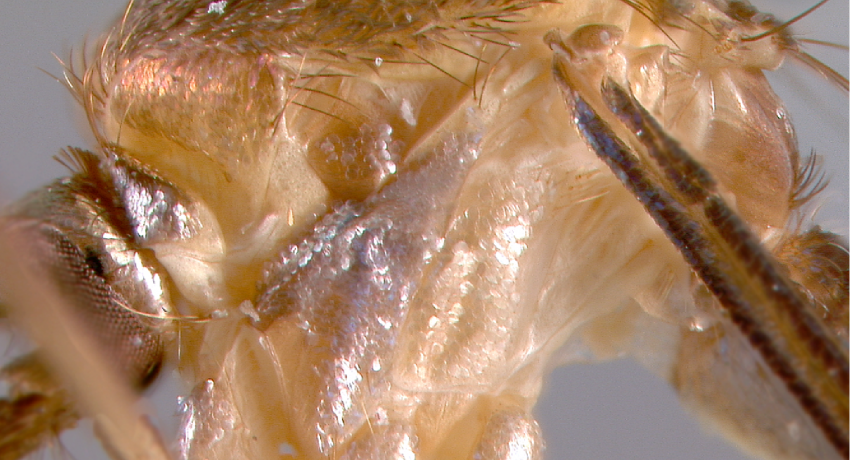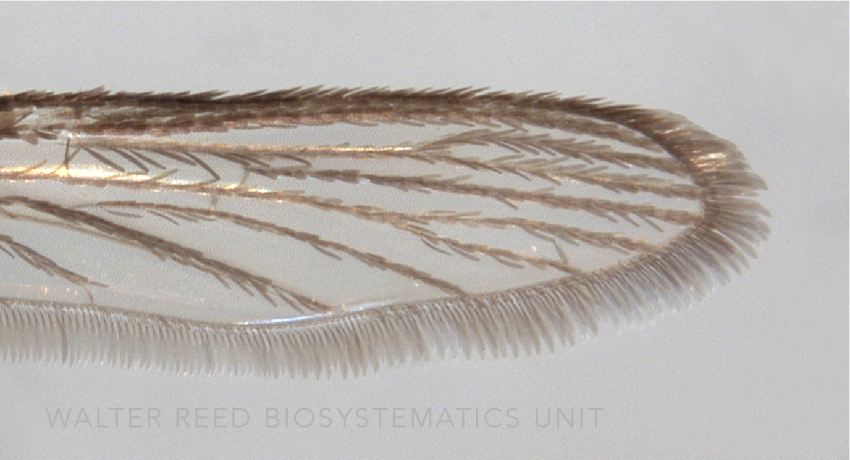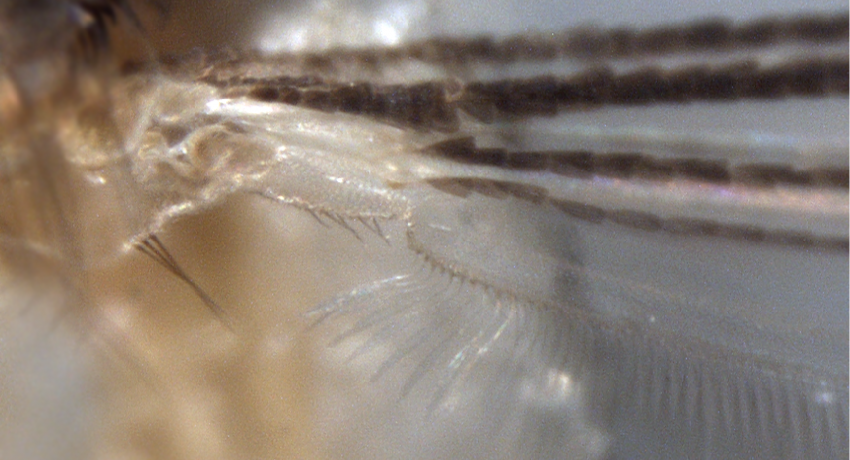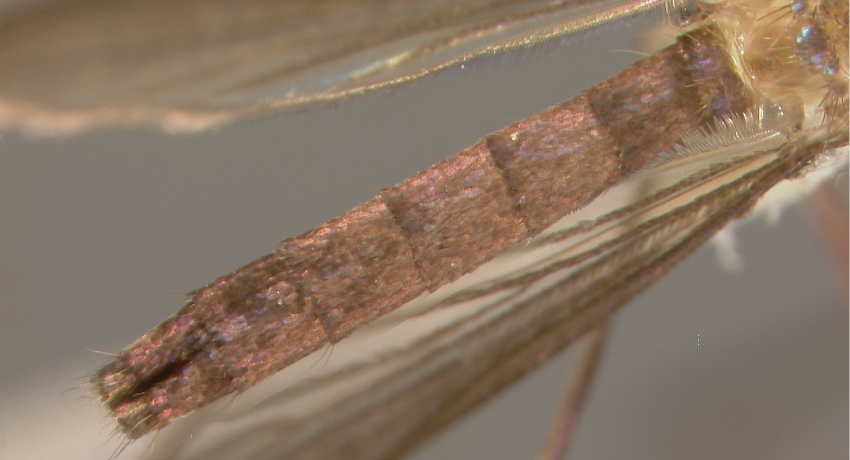NEOTROPICAL REGION
Generic abbreviation: Tr.
Type species: Trichoprosopon nivipes Theobald
Etymology: hair & face or front (Gr.) [ref. to setulae on clypeus]
Species of Trichoproposon are large attractive mosquitoes with a characteristically hairy clypeus. The genus comprises 13 formally described species and two subspecies: Tr. andinum Levi-Castillo, Tr. brevipes (da Costa Lima), Tr. castroi Lane & Cerqueira, Tr. compressum Lutz (with subspecies compressum & mogilasium (Dyar & Knab)), Tr. digitatum (Rondani) (with subspecies digitatum & townsendi Stone), Tr. evansae Antunes (in Lane & Cerqueira), Tr. lampropus (Howard, Dyar & Knab), Tr. lanei (Antunes), Tr. obscurum Lane & Cerqueira, Tr. pallidiventer (Lutz), Tr. simile Lane & Cerqueira, Tr. soaresi Lane & Cerqueira, and Tr. vonplesseni (Dyar & Knab).
DIAGNOSTIC CHARACTERS (Click photos to view; mouse over and click large photo to zoom in.)
ADULT (illustrated): Head: Proboscis not long–about same size as forefemur (Fe-I); clypeus usually with lateral setae. Thorax: Antepronotum well-separated, small; long row of setae on the lower mesokatepisternum; lower margin of mesepimeron above level of lower mesokatepisternal setae; mesopostnotal setae present; postprocoxal scales absent; prespiracular setae present. Abdomen: I-Te with sparse scales distally.
LARVA (not illustrated): Head: Hypostomal suture complete; occipital foramen circular with a distinct collar (Col); maxilla with a maxillary brush; cardo fused with the base of the maxillary palpus. Thorax: Seta 8-M absent. Terminal segments: Pecten absent; siphon without mid-ventral filaments.
TAXONOMIC KEYS
Darsie 1985 (Argentina)
![]()
WRBU – Genera – Global – Larva
![]()
WRBU – Genera – Neotropical – Adult
![]()
WRBU – Genera – Neotropical – Larva
Exemplar DNA sequences
Tr. compressum COI: MF172405
Tr. digitatum COI: KF671032-33, F172406–08
Tr. evansae COI: KM593039
Tr. pallidiventer COI: MF172409–11
All Trichoprosopon DNA sequences
BIONOMICS
Immatures
Trichoprosopon immatures are found in temporal plant containers—bamboo internodes and fallen leaves, spathes and fruit husks—subject to flooding. To avoid their offspring being washed away by heavy rainfall, females gather up their laid eggs with their hind legs and guard them until the neonates hatch. Trichoprosopon compressum and Tr. pallidiventer occupy bamboo internodes with larger exit holes and foul waters caused by decaying organic matter, whereas Tr. soaresi inhabit internodes with smaller (2mm) holes and clean, clear waters without organic contamination. Trichoprosopon compressum, Tr. digitatum, Tr. pallidiventer and Tr. soaresi larvae are obligate or facultative predators.
Adults
Trichoprosopon species can become locally abundant. Trichoprosopon digitatum is the most common of all Trichoprosopon species, and can become a biting nuisance in forest plantations. It is ecologically diverse, host-seeking and ovipositing in natural and artificial containers high in the canopy and at ground level. In Atlantic Forest in southern Brazil, Tr. pallidiventer comprising over 59% mosquito catches at sunset.
*Associated pathogens: This list reports bacteria, viruses, and parasites recovered from, or experimentally passed through this species, and does not imply field vector status.
IMPORTANT REFERENCES (full citations below)
Theobald 1901a: 98; 1901c: 283 (as genus)
Stone 1944: 335 (taxonomy)
Forattini 1965 (taxonomy, bionomics)
Belkin 1968b: 34 (taxonomy)
Zavortink 1979a (taxonomy, review)
Zavortink 1981 (taxonomy, review)
Darsie 1985 (keys; Argentina)
Mitchell & Darsie 1985 (review, bibliography, distribution; Argentina)
Harbach & Peyton 1993 (L mouthparts; phylogeny)
Judd 1996 (phylogeny)
Harbach & Kitching 1998 (phylogeny)
Harbach & Peyton 2000 (phylogeny)
Harbach et al. 2007b (phylogeny)
VALID SUBGENERA
None
CURRENT GENERIC SYNONYMS
syn. Joblotia Blanchard 1901: 1046. Type species: Trichoprosopon nivipes Theobald.
syn. Hyloconops Lutz: 1904: 49, 55 (as genus). In Bourroul 1904. Type species: Hyloconops pallidiventer Lutz. Belkin 1968b: 35 (synonymy).
syn. Trichoprosopon, subgenus Vonplessenia Lane & Cerqueira 1942: 501. Type species: Lesticocampa vonplesseni Dyar & Knab. Zavortink 1979b: 11 (synonymy).
syn. Trichoprosopon, subgenus Limamyia Lane & Cerqueira 1942: 500. Type species: Isostomyia brevipes da Costa Lima. Zavortink 1979b: 11 (synonymy).
CITED REFERENCES
Belkin, J.N. (1968b). Mosquito studies (Diptera, Culicidae). IX. The type specimens of New World mosquitoes in European museums. Contributions of the American Entomological Institute, 3(4), 1–69.
Blanchard, R. (1901). Observations sur quelques moustiques. Comptes Rendus des Seances de la Société de Biologie, 53, 1045–1046.
Bourroul, C. (1904). Mosquitos do Brasil. Faculdade de Medicina da Bahia, 78pp.
Darsie, R.F., Jr. (1985). Mosquitoes of Argentina. Part I. Keys for identification of adult females and fourth stage larvae in English and Spanish (Diptera, Culicidae). Mosquito Systematics, 17(3), 153-23–253.
Forattini, O.P. (1965). Entomología Médica. 3.0 Volume. Culicini: Haemagogus, Mansonia, Culiseta, Sabethini, Toxorhynchitini. Arboviruses. Filariose bancroftiana. São Paulo: Universidade de São Paulo.
Harbach, R.E. & Kitching, I.J. (1998). Phylogeny and classification of the Culicidae (Diptera). Systematic Entomology, 23(4), 327–370.
Harbach, R.E., & Peyton, E.L. (1993). Morphology and evolution of the larval maxilla and its importance in the classification of the Sabethini (Diptera: Culicidae). Mosquito Systematics, 25(1), 1–16.
Harbach, R.E., & Peyton, E.L. (2000). Systematics of Onirion, a new genus of Sabethini (Diptera: Culicidae) from the Neotropical region. Bulletin of the Natural History Museum London (Entomology), 69, 115–159.
Harbach, R.E., Huong, V.E., & Kitching, I.J. (2007b). Systematics of Kimia, a new genus of Sabethini (Diptera: Culicidae) in the Oriental Region. Proceedings of the Entomological Society of Washington, 109(1), 102–120.
Judd, D.J. (1996). Review of the systematics and phylogenetic relationships of the Sabethini (Diptera: Culicidae). Systematic Entomology, 21(2), 129–150.
Lane, J., & Cerqueira, N.L. (1942). Os sabetineos da America (Diptera, Culicidae). Arquivos de Zoologia, São Paulo, 3, 473–849.
Mitchell, C.J., & Darsie, R.F., Jr. (1985). Mosquitoes of Argentina Part II. Geographic distribution and bibliography (Diptera, Culicidae). Mosquito Systematics, 17, 279–360.
Stone, A. (1944). Notes on the genus Trichoprosopon (Diptera, Culicidae). Revista de Entomología, 15, 335–341.
Theobald, F.V. (1901a). A monograph of the Culicidae or mosquitoes (Vol. 1). London: British Museum (Natural History). [424pp]
Zavortink, T.J. (1979a). A reclassification of the sabethine genus Trichoprosopon. Mosquito Systematics, 11(4), 255–257.
Zavortink, T.J. (1979b). The new sabethine genus Johnbelkinia and A preliminary reclassification of the composite genus Trichoprosopon. Contributions of the American Entomological Institute, 17(1), 1–61.
Zavortink, T.J. (1981). Species complexes in the genus Trichoprosopon. Mosquito Systematics, 13(1), 82–85.
CITE THIS PAGE
Walter Reed Biosystematics Unit (Year). Trichoprosopon genus page. Walter Reed Biosystematics Unit Website, http://wrbu.si.edu/vectorspecies/genera/trichoprosopon, accessed on [date (e.g. 03 February 2020) when you last viewed the site].









